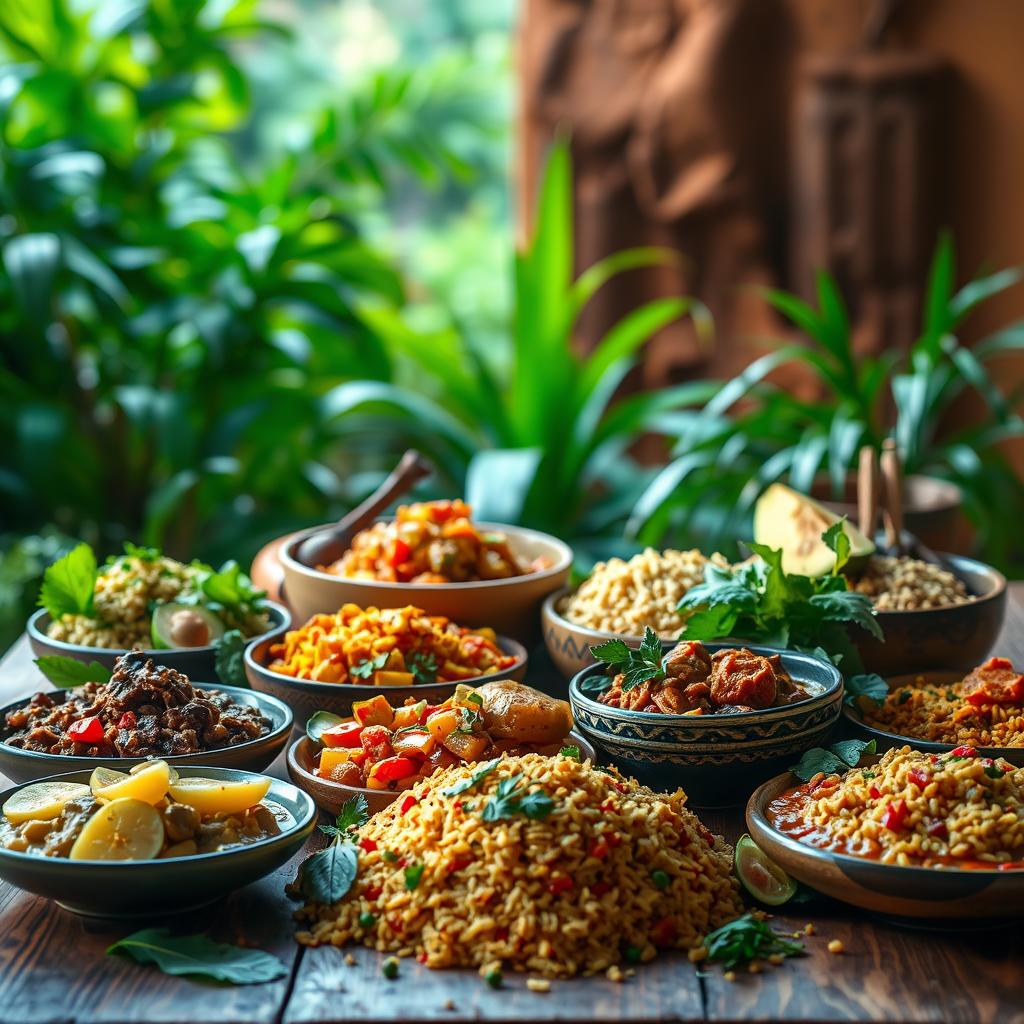Vegan African Recipes open a door to bold stews, savory rice, and bright sides you can make in your kitchen today.
You’ll find one-pot meals like a 30-minute West African peanut stew and hearty bean stews that pair well with fried plantains. These dishes use simple aromatics—onion, garlic, ginger—and pantry spices so you can get great taste in less time.
Want oil-free or nut-free options? Many recipes include swaps like kale for spinach, cashew and avocado cream for richness, and tips for storage so leftovers stay tasty for days.
Follow trusted sources such as The Simple Veganista and My Burnt Orange for step-by-step methods that remove guesswork. This guide shows the key ingredient building blocks and the best way to plate mains with sides, so you cook with confidence.
Key Takeaways
- Simple, plant-forward dishes bring West African flavor to your weekly menu.
- One-pot stews and rice trays deliver big taste with minimal time.
- Keep aromatics and spice blends on hand for easy swaps.
- Find oil-free and allergy-friendly options without losing richness.
- Use trusted step-by-step sources to cook with confidence.
Vegan African Recipes: Quick One-Pot Stews for Bold Flavors

If you want bold taste with little fuss, learn a one-pot method that layers aromatics, spices, and root vegetables.
Start simple: sautée onion, garlic, and ginger for about 5 minutes, then add diced sweet potato, tomatoes, and broth. Simmer 15 minutes and finish with peanut butter and leafy greens for a rich peanut stew that takes roughly 30 minutes total.
Adjust heat by choosing your pepper on the scoville scale. Mild jalapeños need less time than hotter varieties. Use peppers and pepper amounts to match your comfort level.
Want oil-free cooking? Use a splash of water to sauté and still get browning. Keep a pantry stocked with broth, tomato products, peanuts or peanut butter, garlic, ginger, and basic spices to speed prep.
| Step | Action | Minutes |
|---|---|---|
| 1 | Sauté aromatics (onion, garlic, ginger, peppers) | 5 |
| 2 | Add sweet potatoes, tomatoes, spices, and broth | 15 |
| 3 | Stir in peanut butter and greens; finish with lemon | 5 |
“A one-pot West African Peanut Stew is ready in about 30 minutes.”
For the full method, swaps, and storage tips, refer to the detailed tutorial at The Simple Veganista.
Vegan African Recipes List: bold, one-pot stews, vibrant rice, and plantain favorites

Here are crowd-pleasing one‑pot stews, golden tray bakes, and plantain plates that make weeknight cooking simple and bold. Each entry notes a defining ingredient and a quick tip so you can choose what fits your time and pantry.
- West African peanut stew with sweet potatoes and greens (one pot) — Saute onion, garlic, and ginger, simmer sweet potatoes in broth and tomato, then stir in peanut butter and greens for a silky finish. Full method: https://simple-veganista.com/african-peanut-stew/.
- Baked coconut turmeric chickpea rice — A tray bake that yields golden rice, tender chickpeas, and mild spices for a crowd‑pleasing main with minimal hands-on minutes.
- Red Red: Ghanaian bean stew with fried plantains — Hearty black-eyed peas stewed and served with crisp plantains; garnish with gari for texture. Learn more: https://www.myburntorange.com/red-red-ghanaian-bean-stew-vegan-vegetarian-gluten-free/.
- Sweet plantain and black bean bowl — Layer roasted sweet plantain, black beans, chili peppers, and herbs for balanced heat and creaminess.
- Oven-baked Cameroon jollof — Tomato-forward rice that bakes until tender; serve with collard greens or steamed vegetables.
- Cremini and oyster mushroom pepper soup — A light, spicy broth with ginger and garlic; finish with basil and a dash of coconut oil for sheen.
- Black beans and plantain stew — Thick, tomato-paste based stew that reheats well and pairs with plain rice.
- Spicy potato lentil soup with kale — Simmer potato and lentils in vegetable broth, add kale at the end to keep color vivid.
- Cameroon koki beans — Steamed black‑eyed pea loaf for special occasions; slice and serve with a bright salad.
- Crispy sweet potato fries — Roast or air‑fry until golden and finish with kosher salt for a fast, crunchy side.
Tip:For extra richness, a spoonful of peanut butter brightens any peanut-forward stew made with tomato and broth. Adjust broth to loosen consistency and control spice levels to suit your taste.
Staples, sides, and sauces to round out your plate
Small additions make a big difference. Start with a crisp protein side, a creamy drizzle, and a reliable grain. These elements balance flavor, texture, and satisfaction on every plate.
Koose: savory fried bean cakes
Add Koose for a protein-rich bite. These fried black-eyed pea cakes fry up crisp and golden and pair perfectly with stews and bowls. Follow the step-by-step method here: https://www.myburntorange.com/how-to-make-koose-savoury-fried-bean-cakes/.
If you start with whole peas, learn to de-hull them first for a smoother batter: https://www.myburntorange.com/how-to-de-hull-black-eyed-peas-step-by-step/.
Silky, dairy-free creams
Drizzle a cashew and avocado cream over hot bowls to add body and cool contrast. My Burnt Orange offers an easy Cashew and Avocado Cream you can blend in minutes: https://www.myburntorange.com/cashew-and-avocado-cream/.
Grains and finishing touches
Serve mains over white rice, brown rice, or cilantro-lime rice. Try naan for dipping. Use a little coconut oil to fry plantains or Koose and finish sides with a pinch of salt and a squeeze of tomato salad. For an african peanut stew, pair with a cool cashew-avocado drizzle to contrast heat and texture.
Technique tips: peppers, prep time, and substitutions that fit your taste
A few technique tweaks help you control spice, texture, and finish in any stew. These steps focus on heat, smart swaps, and saving time so you get a reliable pot every time.
Heat guide: from jalapeño to Scotch bonnet on the Scoville scale
Choose peppers with intent: jalapeño is milder while serrano and cayenne step up the heat. Scotch bonnet brings fruity, searing spice—use sparingly.
Seed and vein chili peppers to moderate bite, chop finely for even heat, and wash hands after handling. For a reference, check the Scoville scale: https://en.wikipedia.org/wiki/Scoville_scale.
Smart swaps: fats, nuts, and greens
If peanuts aren’t an option, almond butter or cashew butter both add body like peanut butter. For greens, collard greens or kale hold up better than spinach in long cooks.
Use tomato paste when you want a thicker base—sauté it a minute to deepen flavor before adding vegetable broth or broth water. Finish with lemon juice to brighten and to reduce heat without losing flavor.
Time-savers: one-pot methods and managing simmer minutes
Bloom spices with ginger and garlic in about 5 minutes, then add sweet potatoes and simmer 15 minutes until tender. Aim to hit those simmer minutes so total minutes stay predictable.
Go oil-free by water sauteing aromatics; a splash of broth water will deglaze and carry flavor into the soup. Add tender greens off the heat to preserve color and texture.
| Step | Action | Target minutes |
|---|---|---|
| 1 | Sauté aromatics (ginger, garlic, spices) in broth water | 5 minutes |
| 2 | Add sweet potatoes, tomato paste, and vegetable broth; simmer | 15 minutes |
| 3 | Finish with peanut butter or almond butter and lemon juice | 2–3 minutes |
“A quick water sauté and precise simmer minutes keep flavor deep while cutting oil and time.”
Conclusion
Finish strong: turn pantry staples into a cozy pot of west african peanut comfort tonight. Start with onion, garlic, ginger, tomato, and vegetable broth, add sweet potatoes, then stir in peanut butter for a silky peanut stew ready in minutes.
Serve the stew with white rice or brown rice and a pinch of salt. If you want more heat, add a scotch bonnet; if you need to cool things, add extra broth and a spoon of peanut butter.
For full step-by-step guides and swaps, see The Simple Veganista’s West African Peanut Stew, My Burnt Orange’s Red Red and Koose, and the Cashew and Avocado Cream here: https://simple-veganista.com/african-peanut-stew/; https://www.myburntorange.com/red-red-ghanaian-bean-stew-vegan-vegetarian-gluten-free/; https://www.myburntorange.com/how-to-make-koose-savoury-fried-bean-cakes/; https://www.myburntorange.com/cashew-and-avocado-cream/; https://en.wikipedia.org/wiki/Scoville_scale




